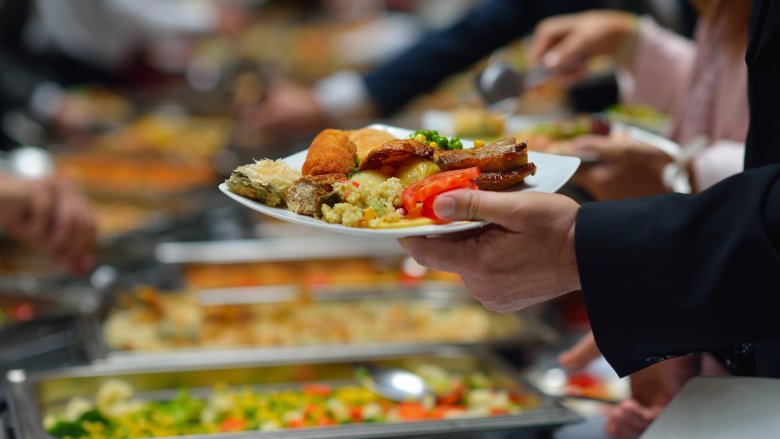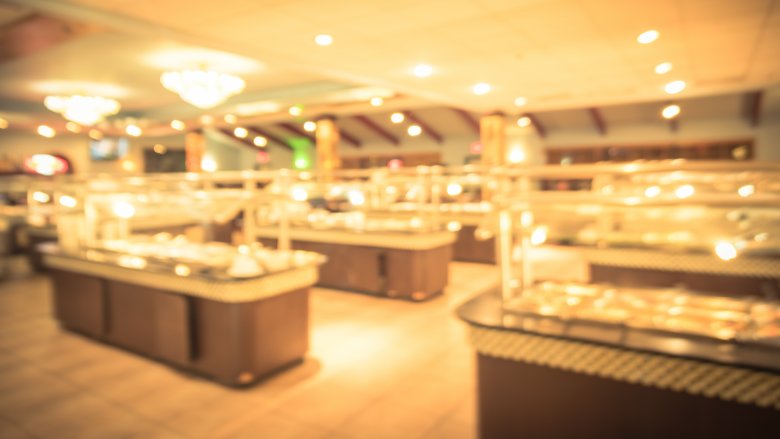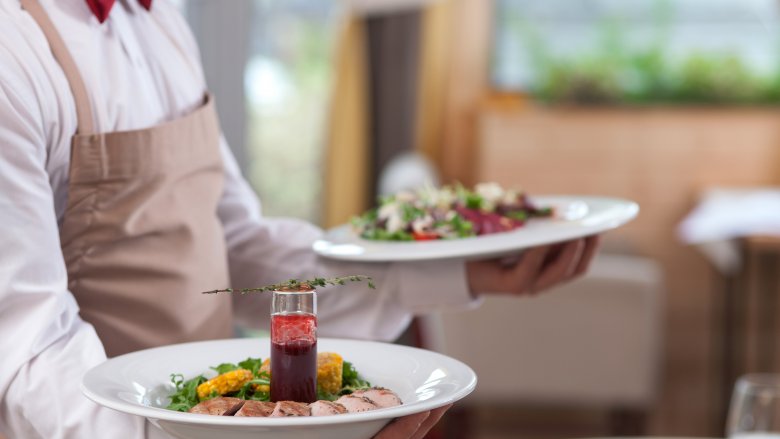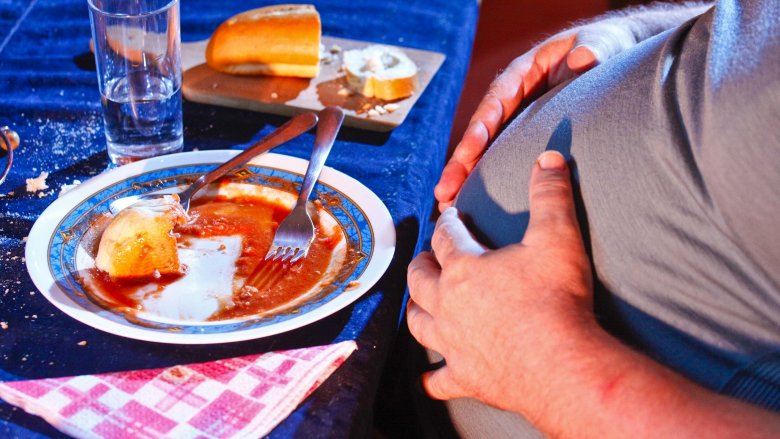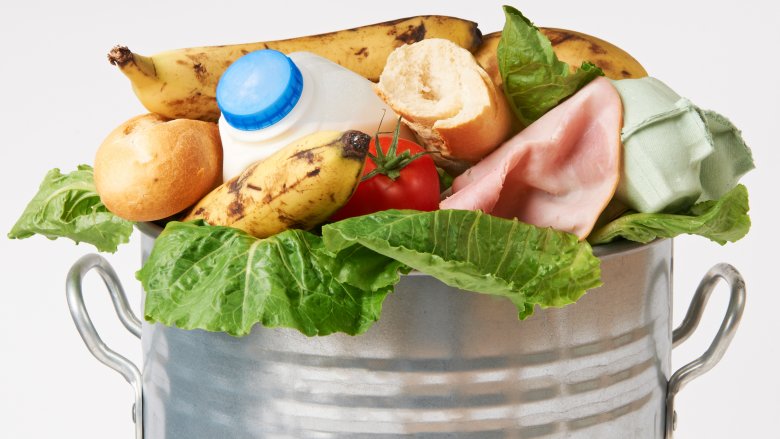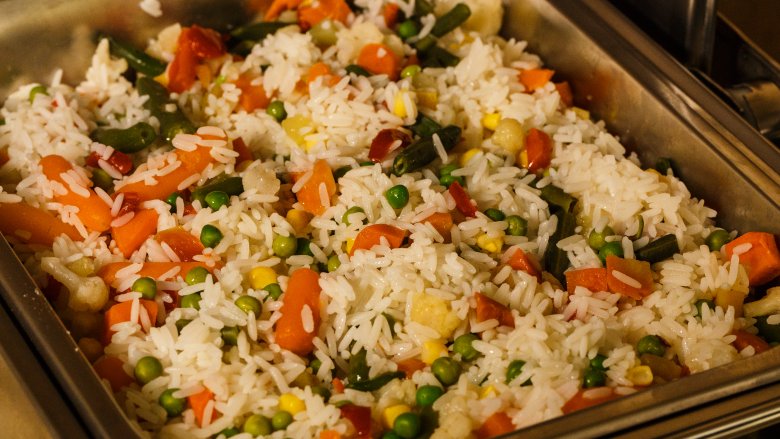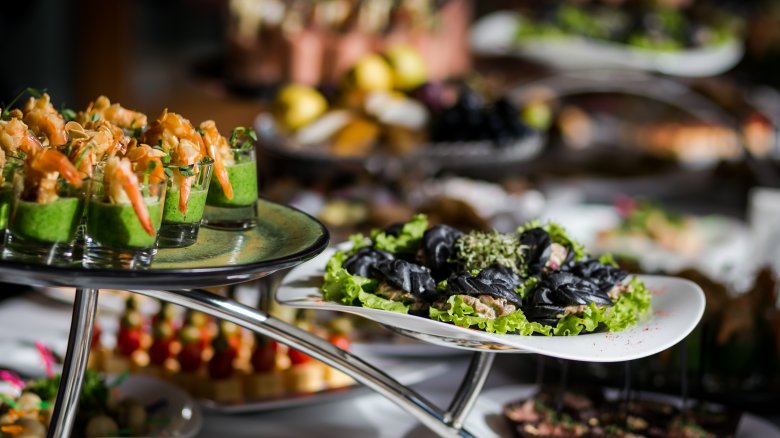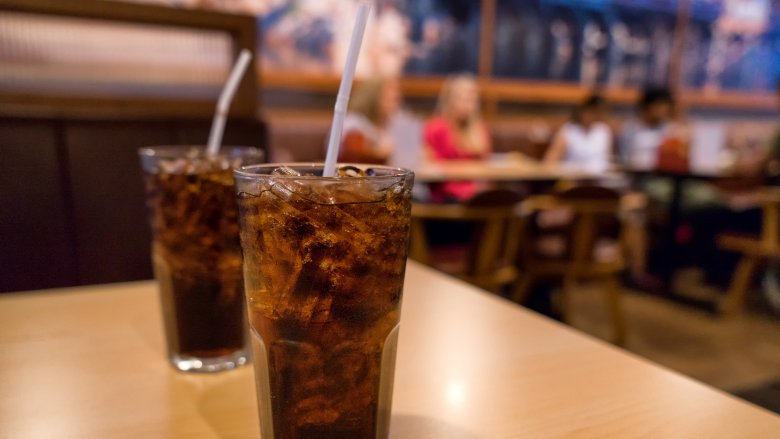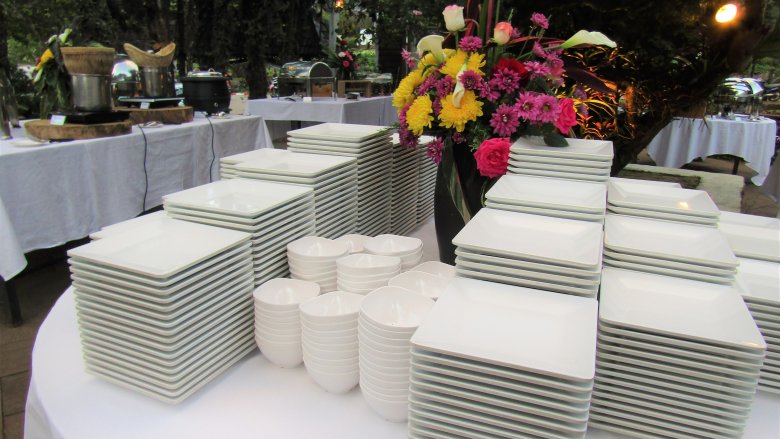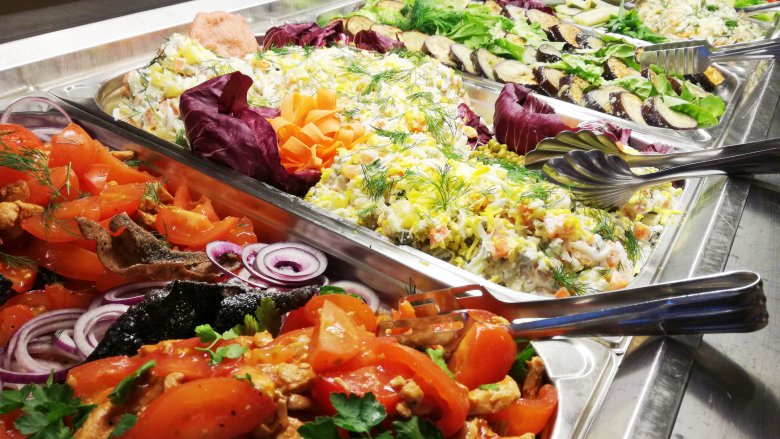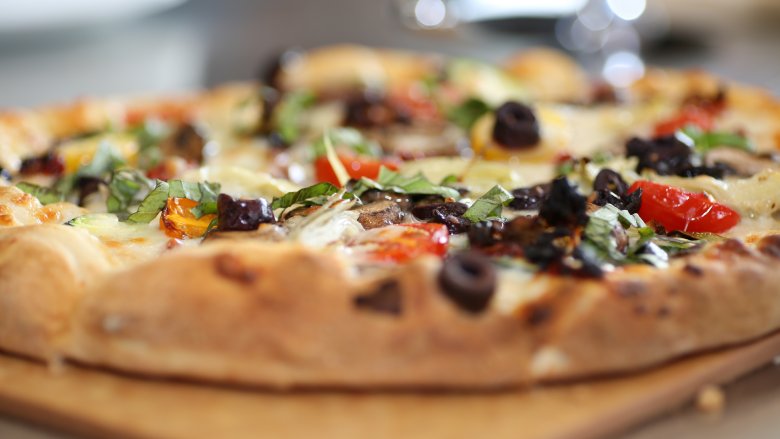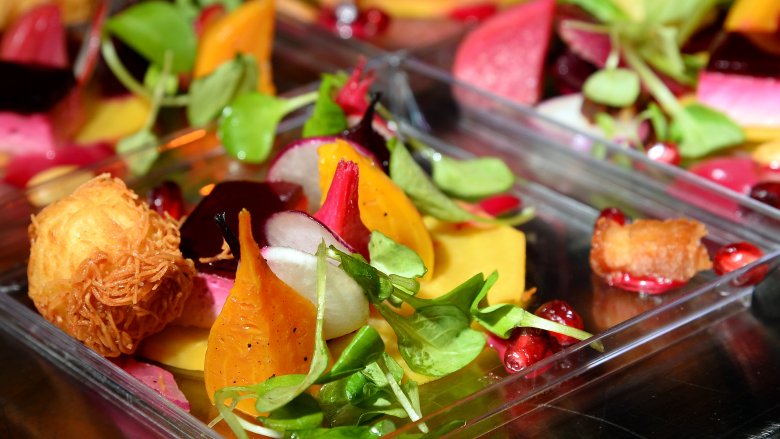How All-You-Can-Eat Buffets Really Make Their Money
If you've ever headed out for dinner at an all-you-can-eat buffet — and most of us have — you probably know exactly who in your group is going to go in super-hungry and attempt to not just get their money's worth, but eat way more than they paid for. There's always one or two, and it's such a common thing it's tough to imagine how these restaurants manage to stay in business. Add in the fact that buffets are notoriously secretive when it comes to their business practices, and it's all a bit mysterious.
It just doesn't seem to make sense. Look around at the other diners. There are always plates after plates, piled high with food. There's probably plenty of waste — it's a great opportunity for people to try something new without making a real commitment, after all — and there are probably people going back again and again. That can't possibly be profitable, right? Let's take a look at what's going on here, and at the strange bit of economics that allows AYCE buffets to not just keep the lights on, but turn a profit.
They shouldn't make money
First, let's talk about what buffets are up against. There's actually an economic theory that says AYCE buffets absolutely shouldn't be successful, and it's the theory of adverse selection. The Economic Times says it's basically a situation where the seller is confronted with probable losses they don't have any control over, and those losses can, in theory, happen for each and every customer that walks in the door.
That's a lot of risk, and Forbes says it's the same principle that's at work in things like insurance, where the seller has no control over their potential risk. With a buffet, though, the risk is typically fairly small. Not everyone is going to be able to eat more than they pay for, and even if they think they do, buffets have some other tricks up their sleeve.
There's one other thing buffets need to take into consideration, and that's walking the line of their pricing. They can't set prices too low, as they'll lose money, but if they price themselves too high, people aren't going to feel like they'll get their money's worth. It's a balancing act, and it's a lot to take into consideration.
Cutting back on overhead
One of the things buffets have going for them is an overhead different than traditional restaurants. Ask anyone in the business and they'll tell you their overhead takes up a huge percentage of their profits. But buffets have a much, much lower overheard... thanks to you. You probably don't even notice you're doing their work for them, did you?
You serve yourself, and in some places, you might even get your own drinks. This means there's next to no need for wait staff, and paying wait is expensive. Since there are no worries about fancy plating or presentation, and since the menu relies heavily on a series of regular dishes, that changes the sorts of chefs they need in the kitchen (and what they can get away with paying them). A large number of the dishes are often prepped in advance, which cuts down on how many people need to be hired to be in the kitchen throughout a service. And at some buffets — like Korean BBQ places — the customers are even doing the cooking as well as the serving.
How food costs balance with super-diners
Food costs are a huge part of running a restaurant, and buffets are no exception. Chef Jonas Mikka Luster told The Independent that food costs are generally between 30 and 35 percent the cost of the meal — and that's standard across the industry. So, if you're serving $10 of ingredients, customers should be paying $30, which covers all overhead with profit tacked on, too.
Straightforward in most restaurants, but at a buffet, they don't know how much a person's going to eat. They still stick with the same percentages and base their pricing on an average food consumption, and here's why it works. Even if a person — let's call him Frank — comes in and eats three times what a normal person would, the buffet still isn't losing money, because they've built their food costs, their overhead, and their profits into what they're charging. Frank also isn't increasing the buffet's overhead by being there, so he's not costing them anything, either. No matter who Frank goes to the buffet with, they're probably not going to eat as much as him — maybe not even as much as they paid for. That helps maintain and boost the profits.
Not everyone is capable of eating like Frank, and even if a buffet finds their average estimates are a little low, they can adjust for that and make up the cash somewhere else.
Minimizing waste
Just like you might have some ways of minimizing waste in your home, buffets have some tricks, too.
Ovation Brands owns and manages around 330 buffets across 35 states, and they have a ton of data on every aspect of their business. They monitor everything, including weekly waste amounts, and plug it into a massive computer model. That allows them to track exactly how much customers are eating and how much is getting thrown away, and allows them to adjust menus based on what's popular — and that varies throughout the year. For example, salads are in higher demand in January, and fish is more popular on weekends. Knowing that means they can plan ahead to put out what people are going to want, and in what quantities.
They also adjust how dishes are served to minimize waste. For each pan, they estimate there's going to be at least five percent and as much as 25 percent waste, so they use small pans. They've also revamped their buffets to serve more individual, pre-portioned items than panned food, and it all reflects in their bottom line.
Cheap, bulk ingredients
Psychology Today took a look at what's going in the buffet line, and they call it the "fill the customer's belly cheaply" metric. No one wants a meal that looks and tastes cheap, but buffets aren't going to make money if they're offering steak. So, they bank on variety and a ton of foods that can be made with certain types of ingredients — ones that are cheap but high-quality and versatile.
For a lot of buffets, those are things like vegetables. You're likely to see a ton of veggie dishes on a buffet, because they can buy veggies for pennies a pound, especially considering they're buying in bulk. Things like carrots and potatoes can be used to bulk up a variety of dishes, and cheap vegetables also have the added bonus of giving health-conscious customers a ton of options. Next time you're at a buffet, just check out how many vegetable dishes there are, then look for the rice- and noodle-based dishes. They're super cheap, too, and they're going to definitely fill the bellies of customers who pile them onto their plates.
Offering seasonal and regional specialties
Another thing you're going to find a lot of on the buffet table are seasonal and regional foods and ingredients. Psychology Today says the benefit to a menu heavy on these ingredients is twofold.
First, if something's in season, restaurants are going to be able to get it much, much cheaper — especially buying in bulk. You see it yourself in the grocery store. Take tomatoes. It's cheaper to get a bushel of those in the middle of tomato season than it is to get a handful that have been shipped in from somewhere else during the off-season, right? It's the same with locally sourced food. If a restaurant is lucky enough to be on a waterfront, for example, becoming a regular, large-scale customer of the fishermen who work the coastline is going to profit everyone involved in the long run.
And secondly, it makes the buffet look good. When they can offer menus advertised with words like "locally-sourced" and "seasonal," it makes customers feel like they're getting something special — and it'll keep them coming back.
They make a mint on drinks
Now, consider your drinks. You're not hitting the buffet without ordering one, right? Chances are pretty good they're not included in the price of the buffet, and while you might not think twice about that, it's one of the ways they're raking in the cash.
When The Motley Fool took a look at the money-making tricks of buffets, this was one of the hidden ones. They say that when buffets sell beverages, they're usually not operating with the same 30 percent food cost that's applied to the rest of the food. Instead, they can apply as much as a 90 percent markup to the sale of drinks. In fact, it's such a money-maker that buffet giant Old Country Buffet stopped their practice of including drinks in the meal price. Now, consider this: many buffets don't have self-serve drink machines and instead, employ someone to bring you a drink. That absolutely limits how many refills you can be bothered to get, raising profits even more.
Giving you smaller tools
Psychology Today says one of the biggest factors impacting your eating habits at a buffet are the tools you're given. You'll almost never see full-sized dinner plates or actual soup bowls and instead, you'll be given small plates, ramekins, and even tiny dessert bowls. Sure, they'll give you a tray to carry all those little dishes, but you're not going to be able to pile many plates on — and that cuts down on how much you can eat per trip. Restaurant suppliers know this, and buffets can even purchase tableware especially designed for buffets. That even includes silverware, which tends to be smaller — but not small enough you'd really notice.
There's a game here, too. Sure, you can make as many trips as you want, but you'll probably have to ask for silverware. Is that last trip up to the buffet worth the bother? You see it now, don't you? One of the exceptions to the rule are Chinese restaurants, but often, the only utensils they'll have readily available are chopsticks. You'll have to ask for anything else, and that's because chopsticks limit how much and how fast you can eat.
A strategic layout
Now, think of the layout of a buffet. There are a lot of similarities across the board, and Psychology Today says there are reasons why everything is laid out like it is — to help the restaurant maximize their profits.
First, you'll come to your salads, your veggies, and if you're in the Chinese buffet, your rice, fried rice, and your noodles. Those are all the cheapest ingredients, and the temptation is to start loading up your plate right away. It's only farther down the line — when you already have a decently full set of plates — that you'll find things like meat and fish.
Check out the way things are served, too. You can grab a massive ladle-full of rice and veggies, but it's tongs when it comes to those inevitably small portions of meat. They'll take longer to get on your plate, and we don't like the pressure of holding up a line, so we tend to move quickly through. Also, pans with more expensive foods are generally less full — a subtle encouragement to take less — while cheap ingredients will be served in giant, overflowing pans. There's plenty for all, and we like that.
Cheaper isn't always better
At the end of the day, buffets need to keep people happy and coming back. It might seem logical that cheaper buffets would get more customers, but there's a weird bit of psychology that says this isn't necessarily the case.
The Cornell Food and Brand Lab of Cornell University conducted an experiment to see how the price of a buffet influenced customers. They offered two groups of customers the same pizza buffet, and charged one group $4, while the other group was charged $8. The group who paid more was overwhelmingly more satisfied with the entire experience, and that says something for the longevity of a buffet.
Sure, a lower price might get more customers in the door, but the customers who paid a higher — but still reasonable — price were more satisfied and more likely to come back. That's what restaurants want to see long-term, and that means adding a few more dollars onto the price might translate to exponentially higher profits in the long run.
People absolutely get banned
So. Frank. We need to talk.
If Frank keeps going to the same buffet over and over again, they're going to notice. They absolutely can — and do — do something about it, and customers who over-eat to an extreme can get kicked out.
It happened to Bill Wisth in 2012. The Wisconsin man was cut off at his local AYCE buffet after eating so much fish the restaurant had to tell him to stop — they were running out of food for other customers. Gawker says the restaurant made it clear it's not the first time Wisth ate them out of house and home, and police were called in to help settle the matter. (Wisth was handed a warning for disorderly conduct after attempting to protest.) And also in 2012, a pair were banned from an AYCE Mongolian barbecue in Brighton after they ate so much — and for so many years — the manager had finally had enough (via The Telegraph). At the end of the day, it is still a business and people who take advantage can get kicked out.
Las Vegas buffets have gotten a makeover
The most infamous buffets of all are the ones in Las Vegas: they're cheap, they're loaded with tons of food, and they're AYCE. Those buffets are still there, but gone are the days of the once-popular $1.99 buffet. They lasted a surprisingly long time, too — but Time reported in 2013 they were gone.
The idea was pretty simple, and it was one buffets could only pull off in Vegas. Their famous $1.99 AYCE buffets weren't designed to make money, they were designed to get people in the door. Once diners gorged themselves on the buffet, they'd hit the adjoining casinos and lose more than enough money to pay for that meal. That worked — at one time — but food trends have changed so much that people pass on the cheapest buffets and are more willing to pay higher prices for better food. As of 2013, Vegas buffet prices hovered around an average of $20 to $25, a huge jump from the $1.99 buffets popular just years before. The shift in trends has been pretty complete, and with fewer people gambling — and gamblers spending less — buffets have become one of the major ways casinos now make their money.
